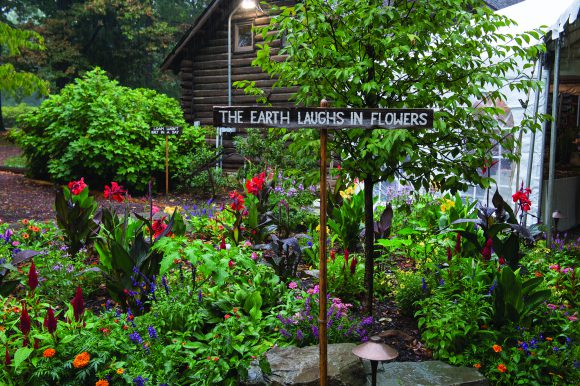
Clever signage in the flower beds surrounding the Log Cabin at the Rutgers Gardens.
As Rutgers Gardens celebrates its 100th anniversary, it’s the perfect time to look back at its roots, celebrate its growth and anticipate a new season for one of the university’s most beloved spaces.
Looking Back
Rutgers Gardens was never meant to be a public space. In fact, quite the opposite was true: according to director Bruce Crawford, the Gardens began as a purely functional learning space for local farmers. In the mid-1800s, ornamental horticulture was a new trend. “You didn’t really landscape your house back then,” quips Crawford. “Having plants and having the time to appreciate and cultivate them was completely new.” So when it became clear that New Jersey was about to experience a housing boom, it also became clear that New Jersey’s farmers—at that time, focused on dairy, poultry, and grain—weren’t prepared to offer the shrubs and trees that were suddenly in demand. The nursing industry simply did not exist.
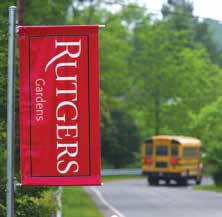
Signage at the entrance to the Rutgers Gardens.
“So, that instigated Rutgers to develop the Gardens,” explains Crawford. “The focus was really for farmers, and teaching them about this new field. “There’s no recorded history of when Gardens’ leadership finished their nursery mission and started to move on, nor do we know what they intended to move on to,” says Crawford. “We may not know how the evolution existed and, to this day, when you walk through the Gardens, you stumble onto this and that.
The Gardens were never denied to the public, but they were also never intended for the public.”
Here’s what we do know: The early 1900s brought additional land and the first display garden. Soon after, in 1936, the Log Cabin was built and hosted its first event. “That’s when you started to see development along the road to the cabin,” explains Crawford. The late 1930s brought a portion of Helyar Woods to the Gardens’ map, and three more display gardens were planted (rhododendrons, shrubs, and lilacs) in 1939. Two years later, the Holly Orchard was established.
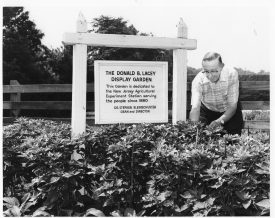
Donald B. Lacey and his Iris Display Garden.
Planting the Seeds
They say that necessity is the mother of invention, and many of the Gardens’ early programs were no exception. According to Crawford, the Gardens as we know them bloomed around 1990, when Bruce Hamilton CC’60, a landscape architecture professor, became acting director and started a strong volunteer program and community component.
Take the first internships, for example. According to Crawford, Hamilton needed help cutting the grass, weeding and mulching the beds, and generally caring for the Gardens. So he secured a vacant house on site for students to live in, and in return, they worked about 10 hours per week in the Gardens. In the summer, it was a paid internship. “Today, of course, our internship program is much more educational,” explains Crawford. Students no longer live on the grounds. The summer internship, which takes them to regional public gardens for discussions as well as hands-on learning, also includes a class about public garden management. “We show students that there are great opportunities out there in public gardening, from Longwood Gardens to Central Park and others,” says Crawford. “This year we will have about 10 interns, but we sometimes have as many as 15.”

1987 Garden Display Event
A similar story accompanies the dawn of the volunteer-supported agriculture program. “In the 1990s, funding was low, and they needed help taking care of the land,” explains Crawford. “So they gave volunteers a small plot of land to grow vegetables on, free of charge, and in return, they helped weed the land.”
Today, this program is alive and well, though perhaps a bit different in practice: volunteers work together to grow vegetables on larger plots of land, rather than maintaining their own smaller gardens. “People exchange ideas, work together, harvest together, and build friendships,” he adds. “It’s what a volunteer program should be.”
A Place That Never Grows Old

Gazebo at the Rutgers Gardens ready for a wedding.
Like any good garden, Rutgers Gardens will continue to grow. Currently, the staff is working on a master plan that will bring cohesion to the Gardens and take visitors on a journey through time and nature. “As you walk through the garden, it would get richer and richer as you move ahead in time,” says Crawford. “You’d start with mosses, move to firs, see flowering plants like water lilies, and eventually over the flowering plants you’ll see a huge mushrooming of plants and the introduction of pollinators. You’d see how plants, insects, and animals work together.”
Of course, this will change the contours of the garden as we know it today. Crawford imagines demonstrating mountain risings and adding pedestrian bridges, a topography maze, and maybe a treehouse. He imagines the Gardens becoming a place where different parts of the university—geology, geography, and others—can reveal themselves and their expertise to the public in a tangible, experiential way. “We don’t want to call it a secret garden anymore. It’s no longer a secret. We want people to be able to visit us once a month for the next 30 years because every time they come, they experience something different,” Crawford says. “I want this to be the place that never grows old.”
Current Programs
There are many opportunities to enjoy all that Rutgers Gardens has to offer. Whether you’re looking to purchase farm fresh produce for your summer barbecue or pick up a few gardening tips of your own, there’s something for everyone.
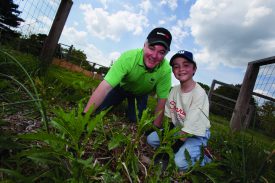
Verizon Foundation working with the NJ School-Age Care Coalition (NJSACC) for a special day of volunteer projects, here at Rutgers Gardens in 2012. Photo credit: Alan Brian Nilsen.
Rutgers Gardens Farmers’ Market: Since 2008, the farmers’ market has provided a variety of products grown and produced locally, from cheese, meat, and veggies to baked goods, soups, wine, and prepared foods.
Festivals and Fairs: Interested in adding flora to your garden? Come to the Spring Flower Fair, the Gardens’ ultimate plant sale. Looking to get the kids away from their screens and into nature? Come to the Fall Festival for a free day of seasonal games, activities, and crafts. Want to pick up a few gardening tricks (or just enjoy a beautiful day outside learning about nature)? Don’t miss the Open House, a free day of tours, classes, and leisure.
Youth Programs: From daylong excursions to weeklong summer camps, Gardens staff help introduce youngsters to the joys of nature.
Education: Garden Series Classes, available all year round, offer beginners and experienced gardeners tips and techniques for improving the home garden, growing plants, and decorating with them. Walks and Talk s, offered the first and third Saturdays most months, are volunteer-led tours of the Gardens with a seasonal focus.
The Hamilton Award
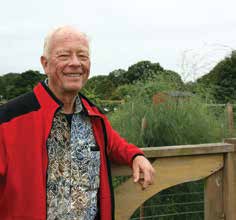
Bruce ‘Doc’ Hamilton.
This year, Rutgers Gardens’ Hamilton Award—previously called the DOC Award, partially an acronym for dedication and outstanding commitment, and partially named for Gardens friend and former acting director Bruce “Doc” Hamilton—goes national.
In previous years, the award recognized outstanding individuals who helped the Gardens in some way. But this year, it gets a makeover. At the Gardens Party in September, the winner of the 2016 Hamilton Award will be a very special person in the horticulture world: someone who is involved with the field not for personal gain, but rather for the love of plants and plant lovers, and someone who puts personal ambition aside for the greater good. “Essentially, we changed the criteria to represent the type of person Bruce is,” says Crawford.
Editor’s Note: This story first appeared in the Spring 2016 issue of Explorations, a publication of the Rutgers School of Environmental and Biological Sciences.

